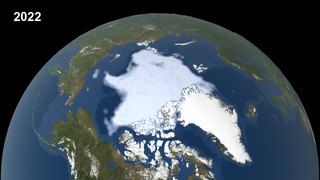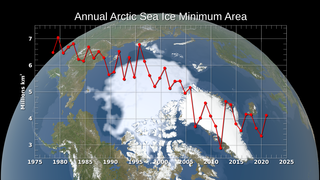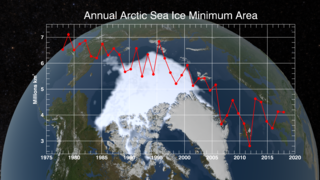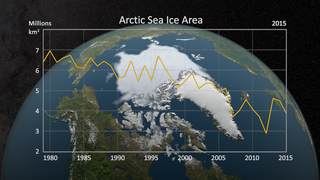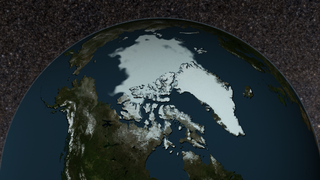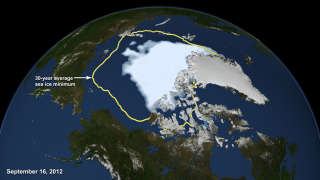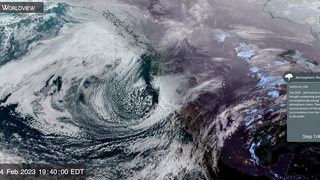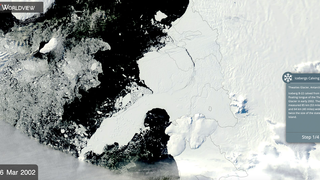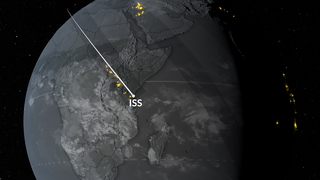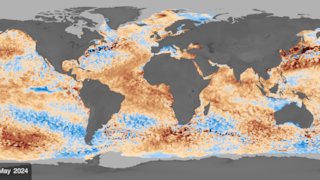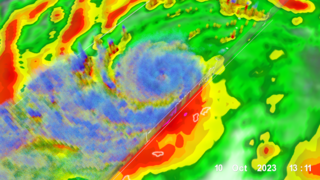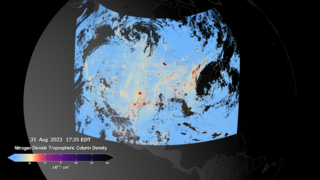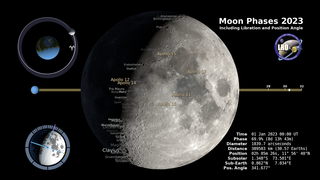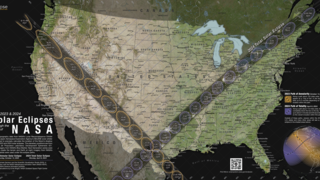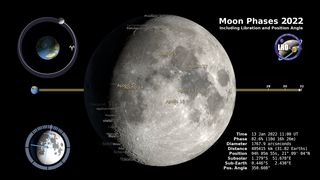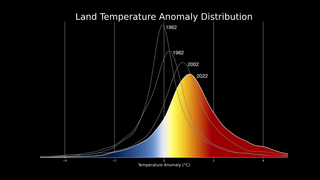Earth
ID: 3893
The continued significant reduction in the area covered by the summer sea ice is a dramatic illustration of the pronounced impact increased global temperatures are having on the Arctic regions. There has also been a significant reduction in the relative amount of older, thicker ice. Satellite-based passive microwave images of the sea ice cover have provided a reliable tool for continuously monitoring changes in the Arctic ice cover since 1979. The ice parameters derived from satellite ice concentration data that are most relevant to climate change studies are sea ice extent and ice area. This visualization shows the annual September minimum sea ice area in the background and a graph of the ice area values foreground. The ice area provides the total area actually covered by sea ice which is useful for estimating the total volume and therefore mass, given the average ice thickness. For more information about these ice datasets, see The Journal of Geophysical Research VOL. 113, C02S07, doi:10.1029/2007JC004257, 2008
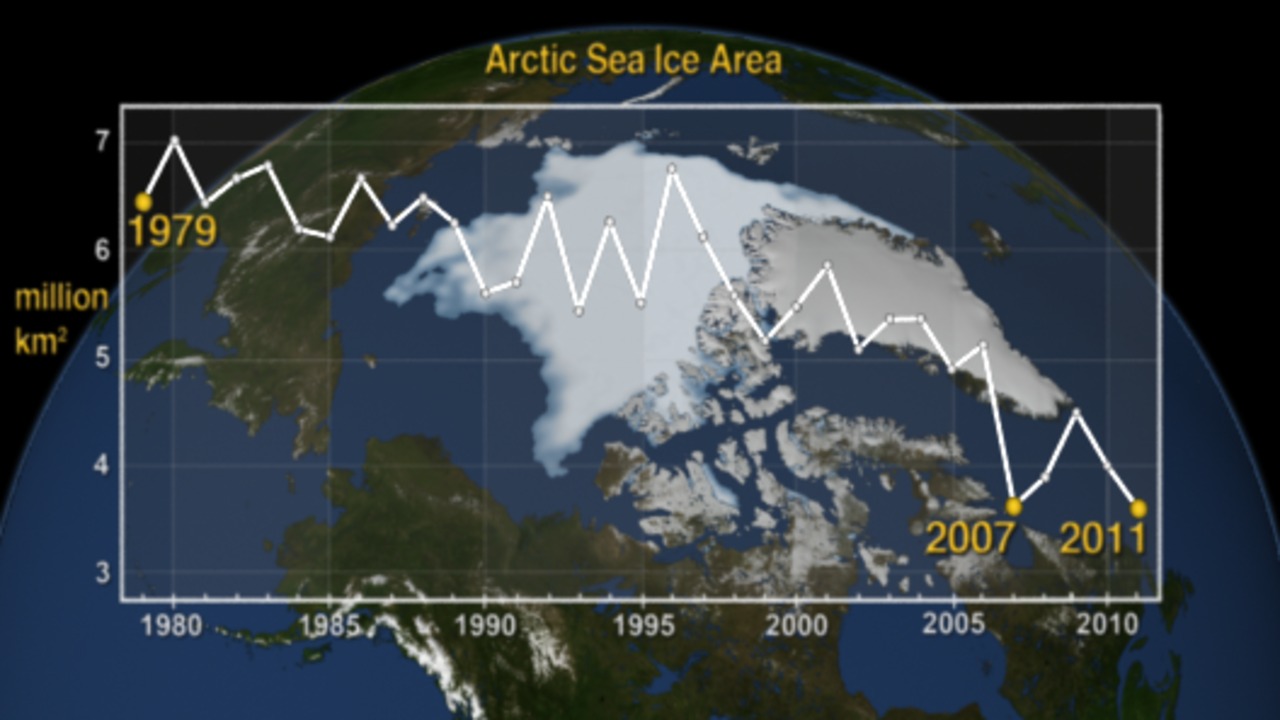

Sea Ice Yearly Minimum 1979-2011 (SSMI data)
There is a newer version of this story located here: https://svs.gsfc.nasa.gov/5170
This visualization shows the annual Arctic sea ice minimum from 1979 to 2011. A graph is overlaid that shows the area in million square kilometers for each year's minimum day. The '1979','2007', and '2011' data points are highlighted on the graph.


Newer Versions
Related
Visualization Credits
Cindy Starr (Global Science and Technology, Inc.): Lead Visualizer
Lori Perkins (NASA/GSFC): Animator
Greg Shirah (NASA/GSFC): Animator
Josefino Comiso (NASA/GSFC): Scientist
James W. Williams (GST): Project Support
Lori Perkins (NASA/GSFC): Animator
Greg Shirah (NASA/GSFC): Animator
Josefino Comiso (NASA/GSFC): Scientist
James W. Williams (GST): Project Support
Please give credit for this item to:
NASA/Goddard Space Flight Center Scientific Visualization Studio Thanks to Rob Gerston (GSFC) for providing the data.
NASA/Goddard Space Flight Center Scientific Visualization Studio Thanks to Rob Gerston (GSFC) for providing the data.
Short URL to share this page:
https://svs.gsfc.nasa.gov/3893
Data Used:
Note: While we identify the data sets used in these visualizations, we do not store any further details nor the data sets themselves on our site.
This item is part of these series:
Arctic Sea Ice
Arctic Annual Sea Ice Minimum with Graph Overlay
Keywords:
DLESE >> Cryology
SVS >> HDTV
GCMD >> Earth Science >> Cryosphere >> Sea Ice
GCMD >> Earth Science >> Cryosphere >> Sea Ice >> Sea Ice Concentration
SVS >> Hyperwall
SVS >> iPod
NASA Science >> Earth
GCMD keywords can be found on the Internet with the following citation: Olsen, L.M., G. Major, K. Shein, J. Scialdone, S. Ritz, T. Stevens, M. Morahan, A. Aleman, R. Vogel, S. Leicester, H. Weir, M. Meaux, S. Grebas, C.Solomon, M. Holland, T. Northcutt, R. A. Restrepo, R. Bilodeau, 2013. NASA/Global Change Master Directory (GCMD) Earth Science Keywords. Version 8.0.0.0.0
https://svs.gsfc.nasa.gov/3893
Data Used:
DMSP/SSM/I
Defense Meteorological Satellite Program Special Sensor Microwave Imager
DMSP/SSM/I/Sea Ice Concentration
Comiso's September Minimum Sea Ice Concentration
Data Compilation - NASA/GSFC - 1979 - 2011This item is part of these series:
Arctic Sea Ice
Arctic Annual Sea Ice Minimum with Graph Overlay
Keywords:
DLESE >> Cryology
SVS >> HDTV
GCMD >> Earth Science >> Cryosphere >> Sea Ice
GCMD >> Earth Science >> Cryosphere >> Sea Ice >> Sea Ice Concentration
SVS >> Hyperwall
SVS >> iPod
NASA Science >> Earth
GCMD keywords can be found on the Internet with the following citation: Olsen, L.M., G. Major, K. Shein, J. Scialdone, S. Ritz, T. Stevens, M. Morahan, A. Aleman, R. Vogel, S. Leicester, H. Weir, M. Meaux, S. Grebas, C.Solomon, M. Holland, T. Northcutt, R. A. Restrepo, R. Bilodeau, 2013. NASA/Global Change Master Directory (GCMD) Earth Science Keywords. Version 8.0.0.0.0

